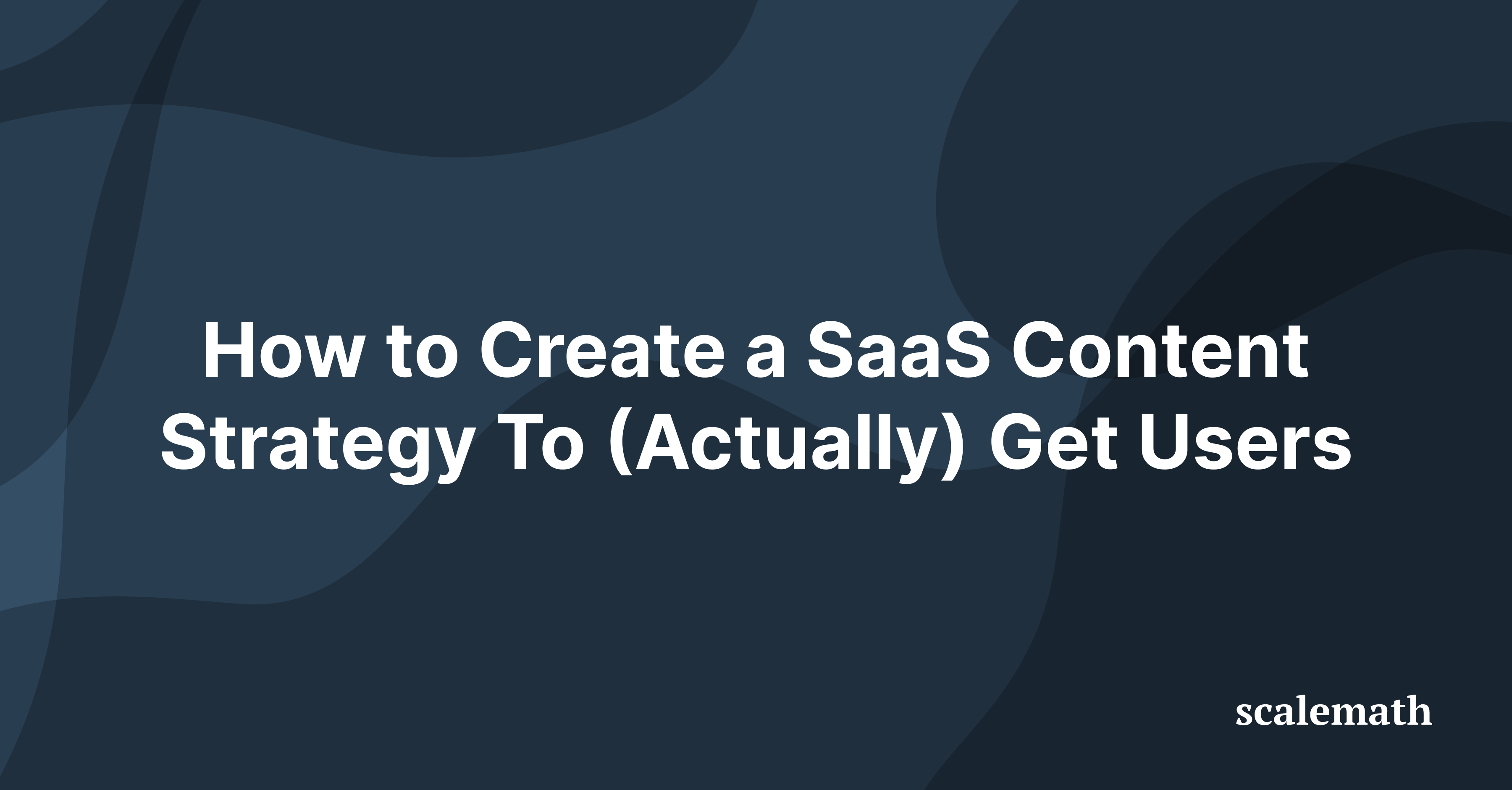Typically, SaaS content strategies are centered around top-of-the-funnel topics that (at best) generate marketing-qualified leads.
And that’s assuming the topics chosen are relevant.
This is common among both in-house content folks and service operators in the industry – even though the latter should, in our view, primarily exist to create content that generates quantifiable results.
The only valid reason to do this is when you are creating a category.
One such company that we publicly work with is Atarim.
Their founder, Vito Peleg, created their own category of visual collaboration – serving a very specific need of bringing product, design, and engineering teams together to ship their best work
Specific need != small market in this case.
In fact, quite the opposite, it’s a solution with a wide set of applications across a whole range of company types, teams, and different users at those companies.
No other company does it (or did at the time, there are always copycats, of course), let alone does it like they do.
Characteristics like this, which may also be true for your company, are a pretty valid reason to default to creating top-of-the-funnel content. You more than likely don’t have much you can do to capture existing demand tightly related to your product category in search.
But, if you do operate in a category that’s defined and has existing demand in search – there are problems with using (or rather mainly using) that approach. Namely:
- You would (or should) want to focus on converting those who are ready to buy first. I mean, who has the time or money to willingly extend their payback period any longer?
- The top-of-the-funnel content you’re creating, unless you are incredibly strategic with topic selection and truly exceptional at engaging with people that become part of your “audience” or “community” will likely yield a very low % conversion rate from lead to user (even, free user).
It is, therefore, our view that it would be a shame not to take advantage of the fact that you operate in a category where there is demand up for grabs.
Yes, thought leadership, or “dinner-party” content as we call it, is sexy, fun, and shareable (all the good stuff), but tackling the bottom and middle of the funnel topics first will, if done right, allow you to capture demand faster and therefore grow faster.
Sidenote: I believe that for almost any startup creating a new category, there are almost always ways to use SEO & content marketing as a viable strategy. Definitely not always on a huge scale, but there are always pockets of demand that you can tap into if done well).
This is all a part of the ScaleMath method, and if you’ve heard of us before, you’ve likely come across me talking about it at conferences or parts of it throughout other articles on our blog.
In this post, we’re going to focus on specifics – by which I mean:
- The types of search targets we go after for the different stages
- Examples of the types of content to create to cater to each
- Breaking down how we would approach setting priorities for your content & SEO team (ultimately, everything in SaaS, both in product and growth, which, although separate teams, should always be considered one function in my opinion).
Note: If you’re interested in working with a partner that’s been there, done that. Knows what it’s like to work with budget constraints and has experienced the same growing pains of operating (yes, literally running) software companies exactly like yours (as well as bigger and smaller) – feel free to take the opportunity to connect with us. We’re here to help. 🤝
Alright, enough preamble, let’s get straight to it.
How To Align Your SaaS Content Strategy To The Growth Metrics That Matter
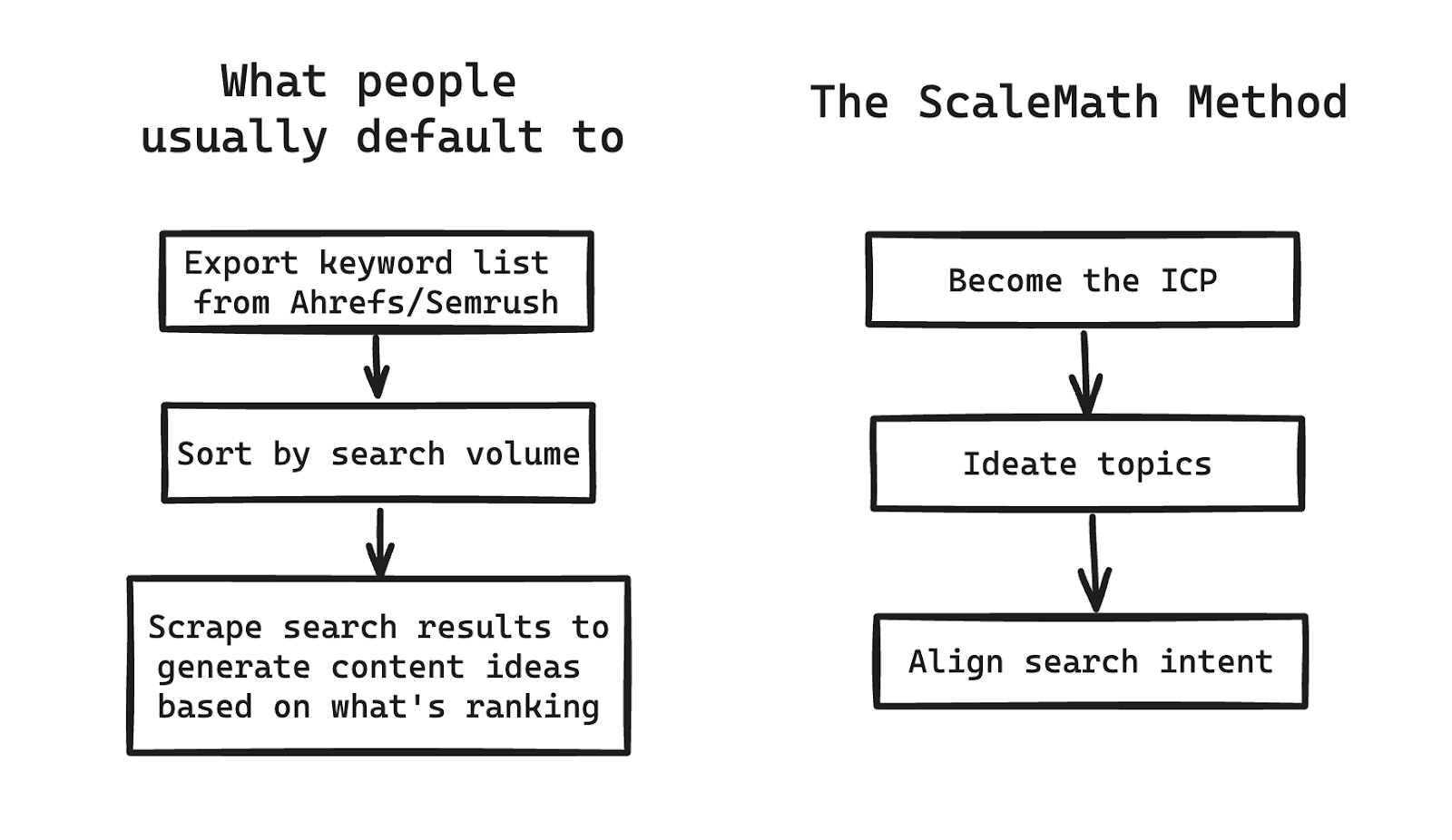
ScaleMath has been in operation for just under a decade.
So, as you’d expect, we’ve come quite a long way since day 1.
Early on, we often fell into what we would now define as bad habits without even realizing it. And, in all fairness, back then, it was relatively easy to generate results with a relatively simple approach.
For example: if you were targeting the WordPress market, you didn’t really need to be all that methodical to get attention from your target audience. Combine a good product that people actually want (and are open to signing up for) with creating content that manages (or even “just so happens”) to reach those people and you could get results.
Even if the content itself is not related to what your product does.
This doesn’t work well – if even at all anymore in most categories – due to a few main reasons, all of which are quite closely related:
- Creating good content is expensive.
- The definition of good content.
- There is a lot of content out there.
- You are competing for attention with at least 50 other companies (even if they aren’t all competitors). Attention isn’t as valuable as it used to be, and it takes much longer to generate ROI in this way.
As a result of this, the ScaleMath method is very heavily centered around creating content that has conversion potential.
It’s absolutely not the only thing we do for good reason.
It’s not always what works, especially not in isolation
I intend to write at length about why, for developer-oriented products, doing that in isolation is almost always going to put you in a losing battle in a future post on developer marketing. Stay tuned for that.
Lots of agencies that just offer this will mislead you into thinking that this is the case. I have no incentive to mislead. We quite literally only exist to do what works (for companies we own & those we advise), and we wouldn’t have made it as long as we have otherwise.
Bottom of the Funnel – Comparison Content
Without knowing the company of every reader, I can confidently say that your content strategy should start here.
These search targets have the strongest indication that a searcher (soon-to-be reader) is most likely to be interested in what you have to offer now.
- “Best X software”
- “[use case] software”
- “[competitor] alternatives”
- “[industry] software”
Example: The 12 Best WordPress Form Plugins (Ranked by Quality & Security)
These are keywords that most SaaS companies compete with each other on with paid ads but quite frequently either don’t think to use SEO/content to do so or choose not to do it from an ideological standpoint that they don’t want to write about competitors, or write list posts that feature themselves, etc.
The principled decision is generally one I “respect” in the sense that I like principled people, and it comes from a good place. But, it also comes from a place of only being familiar with low-quality content.
As with a lot of things in software, the devil is in the details.
You wouldn’t expect people to like your product if you wouldn’t spend as much time as you (and your team) do polishing it & making sure it works really well. And nobody’s expecting you to like content that doesn’t represent what your brand stands for and doesn’t care about attention to detail.
When we start working with a company, this category of content is where we like to focus the majority of our energy.
Examples of Category Content & Keywords
If you’re building a CRM, the keywords in question would be things like:
- Best CRM software
- Best sales software
- Sales software for X
- Etc
Hopefully, you get a good sense of what this would look like for your company. Of course, for the purposes of not turning this post into an actual book, this right here scratches the surface. Each company has a pretty good number of options just based on the category theme.
Using a real example from Rank Math. Another company we worked with right up until they were acquired & the founders had an incredibly successful financial outcome.
Quite literally, the main keyword is “best WordPress SEO plugin” as that is what they are and the category that they operate in.
The search intent for this keyword is actually a list post, which is why that’s what you’ll observe in the top 3 positions in SERPs, but that doesn’t mean you can’t rank with a landing page. In fact, this is what Rank Math did because we ultimately decided, given the competitor landscape, that writing an article that compares us would have been out of place from a brand perception standpoint, so we made the decision not to go there.
Bottom of the Funnel – Comparison Content
The second type that has the highest conversion potential is targeting comparison keywords. Think things like:
- [competitor] alternative
- [your brand] vs. [competitor]
- etc.
And if you’re building something in a big, defined category like CRM software – there are going to be ways that you can go deeper by tapping into even more specific searches related to your competitors.
Competitor content is something we find a lot of founders/CEOs we work with are very delicate with, and fear they will even run the risk of painting their own brand in a bad light.
They fall into the mindset of: will people not see this and think, “well, if X were really that good, then they wouldn’t have to produce this type of content to target their competition”.
Well, yes, that would be true if the entire market already knew exactly how you were better than your competitors. However, most companies enter defined markets in an effort to disrupt existing players that are incumbents in the market and of their respective categories.
And again, this comes down to the approach, down to the detail.
I love working alongside principled founders because I think everyone on our team would agree I’m very principled and are themselves also very principled – I mean, if that weren’t the case, they wouldn’t share our values and wouldn’t be on our team. The tendency to believe that this is the case comes from working with people who don’t understand the level of attention to detail and nuance involved with content. And I don’t even say this from the point of talking down to the people you may have worked with before that led you to come to this conclusion, we ourselves pull our hair out trying to nail product positioning, copy, and obsessing over how we want to frame feature releases – day in & day out.
Middle of the Funnel Content: Problem-Oriented Searches
Eventually, once you exhaust the search targets with the highest conversion intent, you have to move higher up the funnel. To make it easy to remember, let’s call this “middle of the funnel”. There is really one core characteristic of content you want to look for when ideating topics for this part of the buyer journey:
Does the search intent of this search target indicate that the person could match our ideal customer profile?
If you’re able to answer yes to this question (with a reasonable degree of confidence) then it’s a pretty good sign that creating this piece of content is of value.
In terms of content operations for those of you doing this on a large scale, I also want to take a moment to talk about how this could look for you operationally.
We use Asana for project management, and each content project has a custom field that looks like the one below (or a variation of it tailored to the company).
Rating topics like this is a qualitative way to assess the potential conversion impact of a topic (assuming that everything else lines up, i.e., content meets ScaleMath standards, content ranks, etc.).
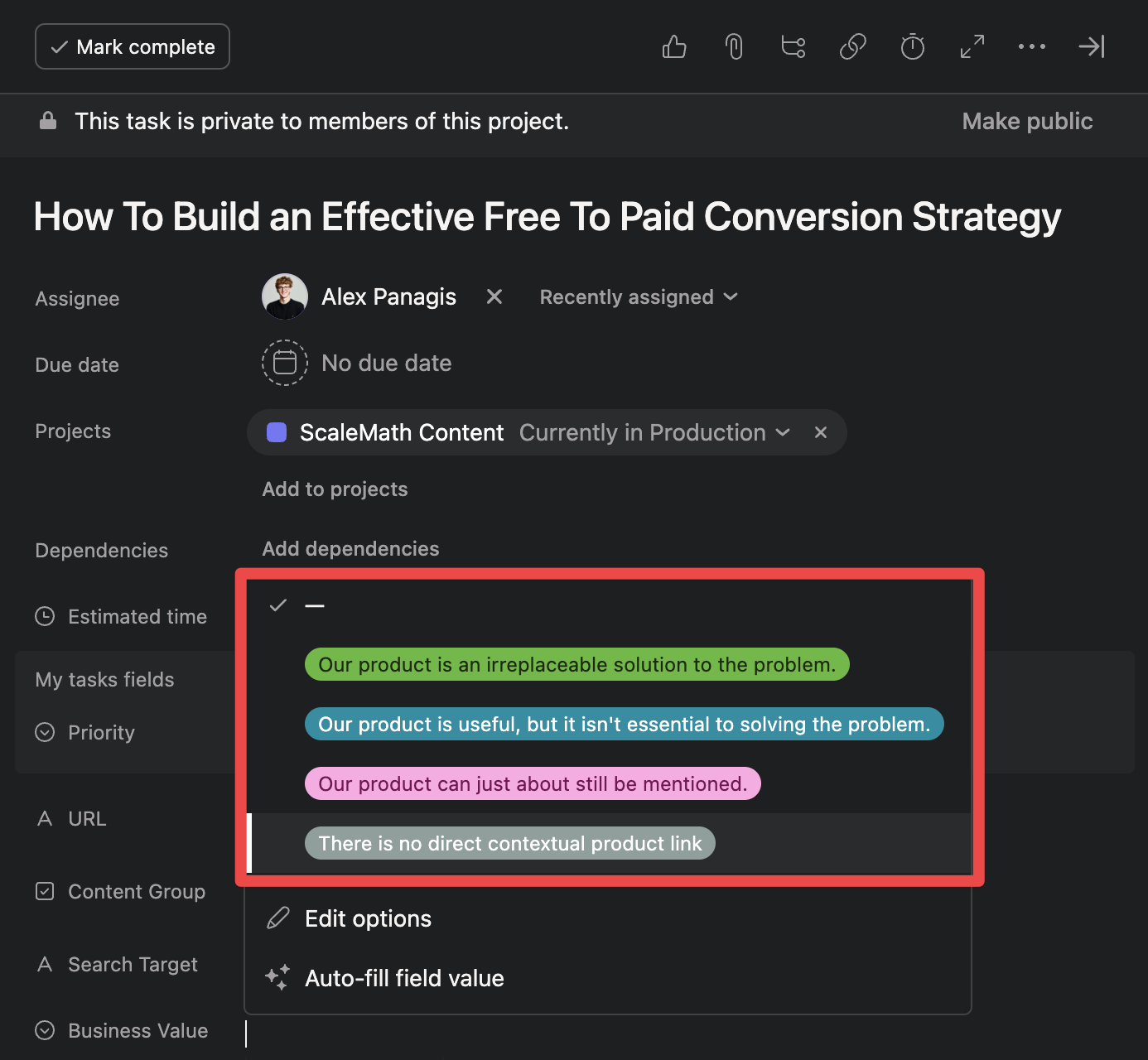
Based on this, we’re able to apply a simple (yet effective) ranking algorithm to prioritize work, which removes the element of guesswork.
- Due date: This acts as a manual override. Sometimes, a product update or something that is part of a partnership is obviously time-wise going to need to be tackled first. Setting a due date automatically bumps this to the top of the list.
- Business Value: as described above, our qualitative metric of what the potential conversion impact is of a particular piece of content.
- Est. Monthly Traffic: assuming this piece is successful (based on meeting ScaleMath standards and ability to rank the post in the top 1-3 positions in search), how much traffic does this post receive.
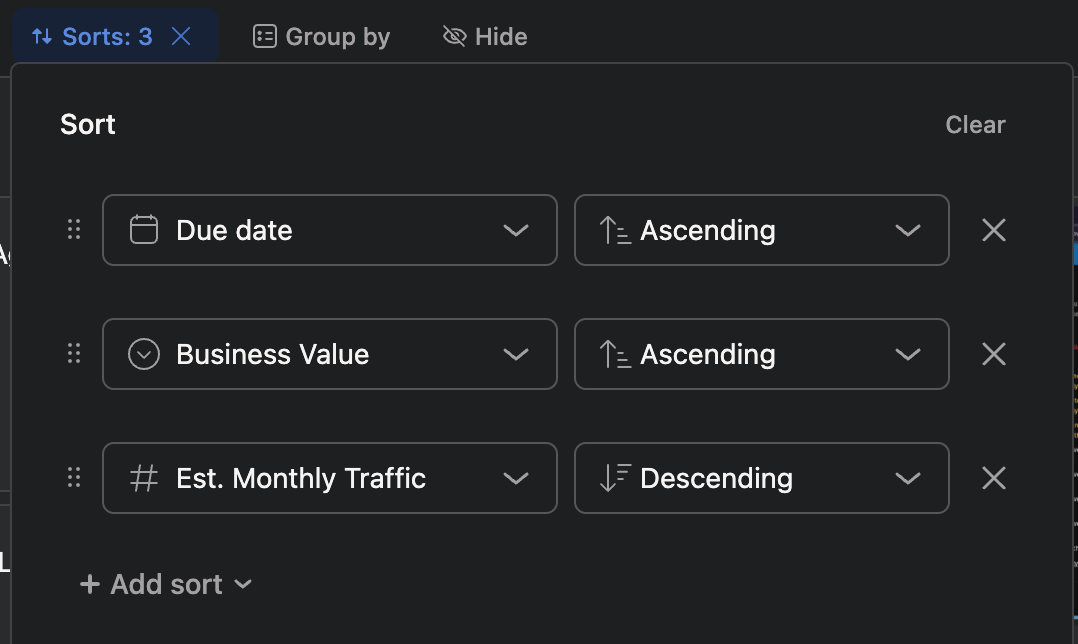
Examples of Middle of the Funnel Content
The type of content that we see most successful at the middle of the funnel is:
- How to guides: Specifically where the product does address the core problem at hand, i.e., if you’re talking about installing WordPress on OpenLiteSpeed manually but have a tool that can be used to manage a VPS server & install OpenLiteSpeed, this is obviously going to be a great piece of content to write.
- Templates: A lot of the work we do is protected by NDAs, but a good example I can share is Workable (which we do not work with). If you’ve ever hired for a role, you’ve almost definitely come across content from them because you searched something along the lines of “software engineer job description example” or “template”.
- Other problem-oriented searches: A lot of people think that problem-oriented searches can only be addressed with “how to” content. This isn’t really the case, because a lot of the time, people who have a particular problem aren’t literally searching for “how to do X”. Sometimes they don’t even know exactly how to describe the problem they have, so there are some topics that fall into this area.
Top of the Funnel Content: Your Ideal Customer Wants It, But It’s No Indication That They Want You
And lastly, we have the top of the funnel.
I was about to start this section off by saying “last but not least”, but that would be misleading. Top-of-the-funnel content is last for a reason. It should be treated as a lower priority for most companies. What I mean by this is not that no top-of-the-funnel content should be created until all of the bottom and middle-of-the-funnel topics have been exhausted.
In fact, please don’t do that. There are strong reasons not to.
And that brings me to why top-of-the-funnel content is still incredibly important.
People don’t read a post and convert. There are subconsciously thousands, if not 10s of thousands, of considerations that people make when choosing a product over another product (or whether to use a product at all instead of just sticking to Google Sheets).
Your top-of-the-funnel resources should be created with the attention of doing one main thing: serving your ideal customer profile and existing customers. Assuming this is done (again, to a high standard, as the details matter) – the waterfall effects will include but not be limited to:
- Capture the attention of your target market. Even if not people who already have a high problem/solution awareness).
- Improve the retention of existing customers. This is particularly applicable if the product being sold is somewhat complex, and has a learning curve (higher time to value). By publishing lots of educational content, we help our users figure it out, achieve their goals, and stick with us for longer.
- Help your customers (and potential customers) run a better business of their own. Even if our content is not directly associated with the product, if it helps our audience run more successful businesses of their own, then the byproduct of this is an increased chance they remain a user for longer.
- Reactivate past customers. The common re-activation technique is to send your churned users an email list of all the new features added since they left. We showcase our product wherever relevant in our own content, so this mechanism is built-in there.
- Aid revenue expansion. By reading our articles, our users might discover some functionality that is not available on their plan (and upgrade), or by helping them grow, we teach them to scale their operation, leading them to upgrade to a larger plan.
- Fuels the Word Of Mouth growth. When we teach our users something cool that helps them be more successful and achieve their goals, we’re giving them a “talking point” to share with their friends.
- Tap into the “Mere Exposure Effect”. The more eyeballs we get on our articles, and the more we mention our product within them, the more “familiarity” we create in the minds of prospective customers.
- Build a solid reputation in our field. People want to buy from someone who knows what they’re doing. By publicly sharing our knowledge, we promote ourselves as credible experts that you can trust (and buy from).
- Remove strain from our customer support team. The more educational content you create, the fewer support requests we’re going to get.
- “Get featured”. The chances of people talking about what we’re working on if we aren’t mentioning it on our own site are a lot lower than they would otherwise be. Create a compelling piece of content, and there’s a good chance that it will get picked up. Our content should get people talking about what we’re working on and our product.
After Action Report – How To Start Building SEO As A Scalable Customer Acquisition Channel
So, let’s reel things in.
Having read this, I hope I’ve been able to instill some confidence in every reader as to the efficacy of SEO – which remains one of the very few scalable customer acquisition channels available to anyone operating a software business.
I’ve been in this line of work for nearly 10 years. That equates to observing a lot of people jumping into SaaS because they see it as an opportunity.
We didn’t get into working with software companies on a whim. It’s always been at the heart of everything we do, and our commitment has always been to building exceptional customer experiences.
In fact, we consider ourselves a product strategy & positioning advisory that’s also great at growth because we run & grow our own products where we put what we do into practice. We don’t just bank on being able to sell services (that often don’t work) to customers and run our agency off of doing this for as many customers as possible. We don’t work that way.
And it’s painful to see stories like Michael’s right here.
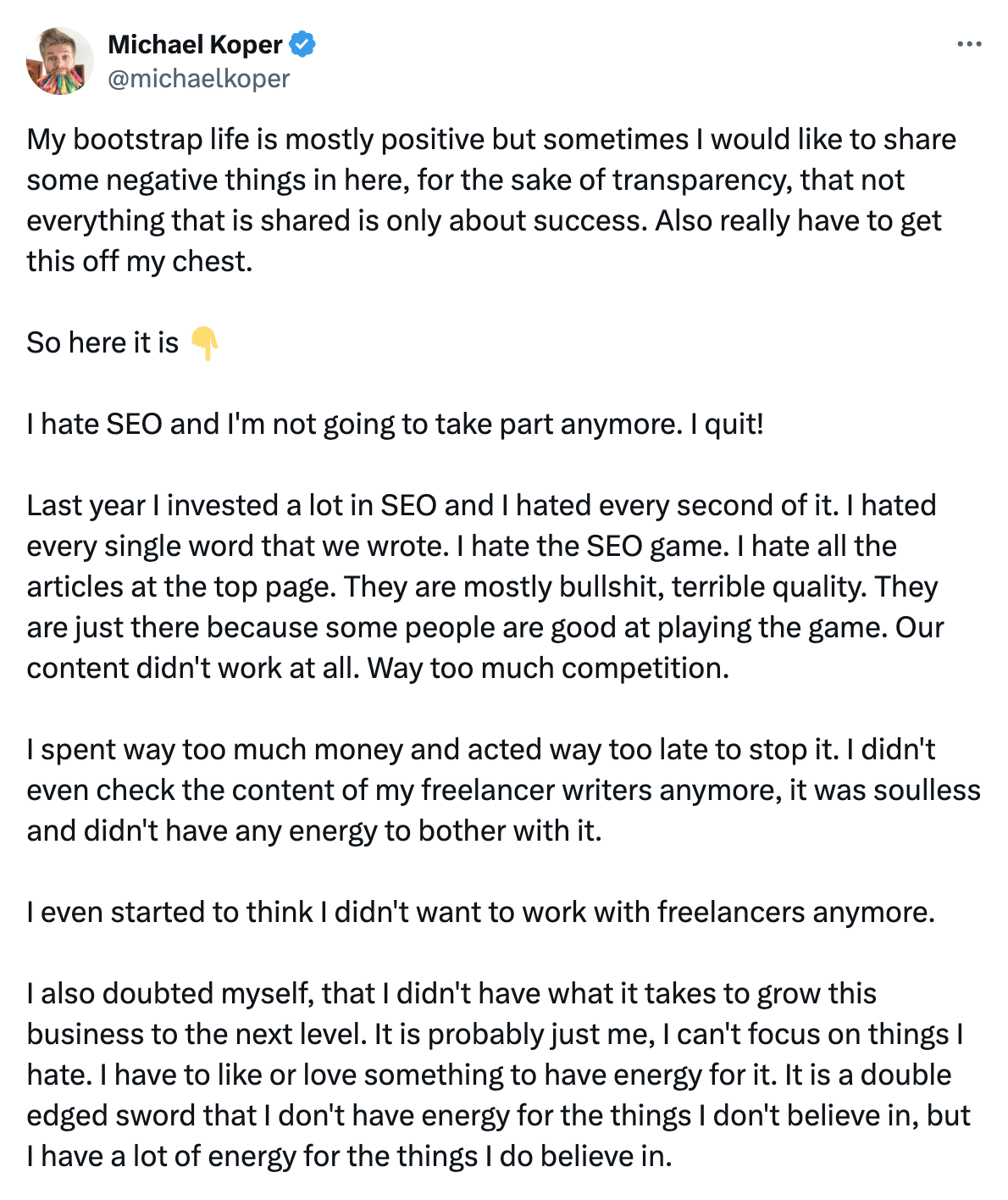
This is just one of the most recent ones I’ve come across, but a lot of people are misled and share a sentiment similar to Michael’s. I actually don’t (and can’t) blame them for reaching this point, and I fully understand why.
What we do isn’t easy. And how we do it isn’t easy. It takes a level of effort that, in reality, makes it difficult to find great talent. There are very, very few people who are able to work at the ScaleMath standard or people who can be trained to work at our expected standard. The intention here is not for this to be self-aggrandizing because it makes what we do really tough, and it means that we can’t help everyone (especially as we’re forced to be selective).
Where do you even start? Great question. The straightforward answer is that you should focus on the bottom and middle of the funnel early on (with priority). Maybe mix in the occasional top-of-the-funnel content if you’re happy not to see quicker returns from it, but it serves another bigger purpose.
Any questions? Ask away. My inbox is always open to our readers: [email protected] 🤝

